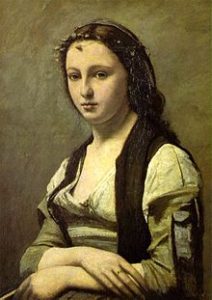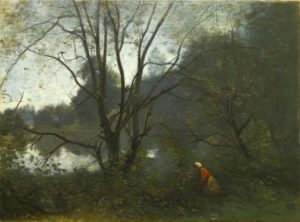
“The Woman with the Pearl,”
Landscape painters are a solitary breed. Think of Van Gogh out under his starry sky, or Cezanne daily planting himself in front of Mount St. Victoire, or John Marin on the rocky coast of Maine. They’re meditative souls, who step back from human society in order to forge a more perfect relationship with nature.
That’s not the whole story, of course. What good landscape painters find, just like all good artists, is not so much nature, but their own vision, so what we see when we look at the paintings is not so much the place and all its particulars, but them.
That was very much the case with Camille Corot, one of the greatest landscape painters ever, and the subject of a lovely exhibit at the Metropolitan Museum of Art. Corot, like so many 19th century landscape painters, was an inspiration to the impressionists, mostly because of the way he came to use light as the dominant element in his paintings.
And yet, Corot was a different breed than the impressionists. He wasn’t concerned with optics, or advancing a system, or making a dramatic technical breakthrough. Nor did he share their bohemian gregariousness, their passion for exchanging ideas, nor their choice of busy motifs like beer gardens or city parks.
Despite his solitary artistic sentiment, Corot never had to struggle for acceptance like the impressionists. He was an establishment painter. At the peak of his career, his paintings were in such demand that he would complain that he had nothing left to sell. His paintings were regularly exhibited in the salons, and he made an effort to do the kind of big, grandiose compositions with mythological and religious subjects that a mid-19th century salon career required.
He was so compliant, in fact, that his life’s work seems almost compartmentalized: He could look like Claude Lorraine or Poussin, and he might today be considered too eclectic, had he not developed his own unique vision, his small poetic paintings.

In some of his grand-scaled paintings, you can almost feel the tension between his intimist nature and his conventional ambitions, his introspective nature and his desire to make a great gesture. Sometimes that tension could produce something strangely beautiful, like “Dante and Virgil,” a painting of almost primitive power. The two travelers stand in the darkened landscape, in some ring of hell. On one side is a she-wolf, on the other a lion, and they are both painted with the naive painter’s disregard for anatomy, as if Corot had decided to reinvent these animals, the way the mind does in a dream.
Although his passion was landscape, Corot painted many pictures of women. Sometimes he stretched out a nude female in the foreground, like a feature of the landscape, but as beautifully as everything is painted, somehow the two never quite work together, as they so often do in Italian Renaissance paintings. His portraits of women, sometimes in exotic or ethnic costumes, are much more successful. They have the meditative calm of his landscapes, but the same solitary quality that makes him more comfortable pushing the figures in a landscape into the background, makes him paint these women as if there were a glass wall between subject and artist. They stand impassive, blank-faced, a bare white arm draping down, and, as lovely as they are, they aren’t really women, or people. They look as if they were made out of porcelain, cold and untouchable.
At the beginning of his career, he painted the Italian landscape, sometimes with classical ruins. But when Corot discovered his true style he reverted to being a French painter, a painter of pure nature. His masterpieces, the paintings that every museum wants, are invariably his river scenes, his so-called souvenirs, reminiscences of a particular place, distilled from memory. These small pictures, many of which are on view in the show, are like dreamlike reveries. They always consisted of the same elements: the bank of a lake or a river, some soaring trees, tall grass, and a small figure, usually with a red hat or vest to set off the predominant green. It was like a stage set that Corot visited again and again, each time coaxing out new poetry.
What makes these paintings so special is the silvery light, a near twilight of early morning or late afternoon without the pinks or violets of sunrise or sunset. This light seems to permeate everything, in an obvious way in those paintings that have a misty quality, but even in those where the air is crystal clear. The trees no longer rely on branches to hold them up, the foliage billows upward like smoke. And the tall grass in the foreground, heavy with seed heads, sparkles with dabs of paint, as if someone had just tossed a handful of confetti.
The show is logically organized, mostly chronological, but it has no real climax, no point at which everything comes to a crescendo. But that was Corot, after all. He never lost his vitality in his long career, but neither did he make any end-of-life bid for something daring. He was a classicist, a lover of harmony, his paintings constructed out of stable horizontals and verticals. He was ever calm, like certain Buddhists whose approach to enlightenment is patient, unaggressive. Here is the river, he seems to say, the silver sky, the trees, the grass – not gorgeous, not spectacular – but it’s all there, and it’s simple and easy and true.

